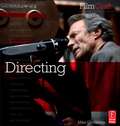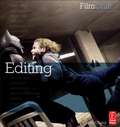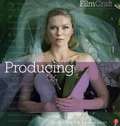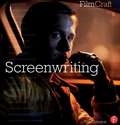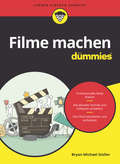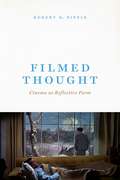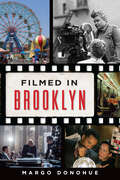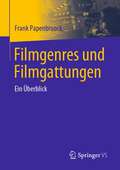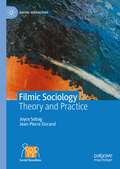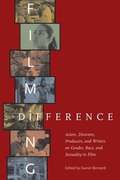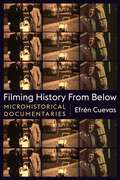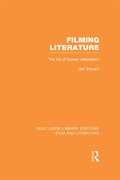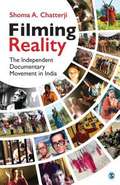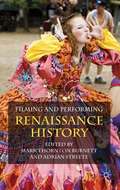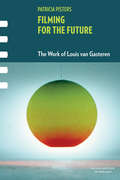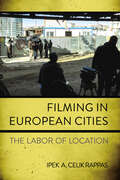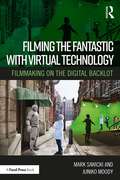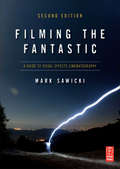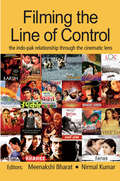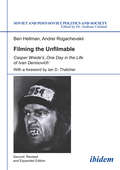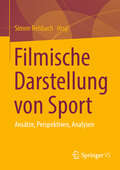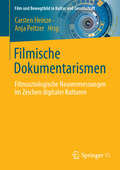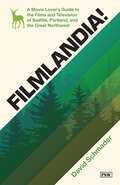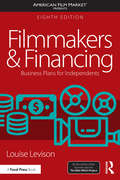- Table View
- List View
Filmcraft: Directing
by Mike GoodridgeThe author tries to encapsulate the craft of sixteen directors in this book to illustrate the complete process of film-making.
Filmcraft: Editing
by Justin ChangPart of the Filmcraft series, this book focuses on editing-- uniquely difficult discipline, where editors interviewed here have themselves expressed difficulty articulating the precise nature of their work.
Filmcraft: Producing
by Geoffrey Macnab Sharon SwartThe book elaborates on the role of a film producer and illustrates the traits and challenges faced during the journey to success.
Filmcraft: Screenwriting
by Tim GriersonThe author portrays the role of screenwriter as the first person charged with shaping the vision of the final film, and how he provides a guiding light for all the artists and technicians who will later add their own individual talents to the project
Filme machen für Dummies (Für Dummies)
by Bryan Michael StollerHeute kann jeder einen Film drehen, nur eine gute Idee braucht es dazu. Der Regisseur und Drehbuchautor Brian Michael Stoller erklärt Ihnen in diesem Buch, wie Sie ein Drehbuch schreiben und ein Storyboard entwickeln, den richtigen Drehort aussuchen, die passende Crew und Darsteller finden, den Film so drehen, dass er gut aussieht. Außerdem erläutert er, was Sie nach dem Dreh beachten sollten: Soundtrack, Special Effects und vieles mehr. Zuletzt gibt er Ihnen noch Tipps, wie Sie den Film an den Zuschauer bringen, sei es im Internet, über einen Vertrieb oder über andere Kanäle.
Filmed Thought: Cinema as Reflective Form
by Robert B. PippinWith the rise of review sites and social media, films today, as soon as they are shown, immediately become the topic of debates on their merits not only as entertainment, but also as serious forms of artistic expression. Philosopher Robert B. Pippin, however, wants us to consider a more radical proposition: film as thought, as a reflective form. Pippin explores this idea through a series of perceptive analyses of cinematic masterpieces, revealing how films can illuminate, in a concrete manner, core features and problems of shared human life. Filmed Thought examines questions of morality in Almodóvar’s Talk to Her, goodness and naïveté in Hitchcock’s Shadow of a Doubt, love and fantasy in Sirk’s All That Heaven Allows, politics and society in Polanski’s Chinatown and Malick’s The Thin Red Line, and self-understanding and understanding others in Nicholas Ray’s In a Lonely Place and in the Dardennes brothers' oeuvre. In each reading, Pippin pays close attention to what makes these films exceptional as technical works of art (paying special attention to the role of cinematic irony) and as intellectual and philosophical achievements. Throughout, he shows how films offer a view of basic problems of human agency from the inside and allow viewers to think with and through them. Captivating and insightful, Filmed Thought shows us what it means to take cinema seriously not just as art, but as thought, and how this medium provides a singular form of reflection on what it is to be human.
Filmed in Brooklyn
by Margo Donohue"Shooting in Brooklyn is like opening a time capsule. Nothing has changed. Everything looks like it did in the eighties." -Freddie Prinze, Jr. Discover the iconic films, legendary personalities and the locations for timeless big screen moments that took place in Brooklyn. From Saturday Night Fever to numerous Spike Lee Joints, readers can learn about Brooklyn's cinematic past or discover locations to visit today.
Filmgenres und Filmgattungen: Ein Überblick
by Frank PapenbroockDieses Buch leistet einen Beitrag zum Verständnis der Bedeutung von Filmgenre-, Gattungs-, Stil- und Formatbezeichnungen. Es verfolgt das Ziel, einen umfassenden Überblick über die vielfältigen, oft wild wuchernden Begrifflichkeiten zu geben, die im Alltag gebräuchlich sind. Dabei beschreibt es in allgemeinverständlicher Sprache die wichtigsten Merkmale, die mit den jeweiligen Bezeichnungen verbunden sind, und arbeitet den Konsens hinsichtlich des dramaturgischen Aufbaus, der Geschichtsstruktur sowie der wiederkehrenden Ikonografie, Musik und Bildsprache heraus.Neben der Vermittlung grundlegender Informationen widmet sich das Buch auch Fragen, die aufgrund der Geläufigkeit der Begriffe oftmals als zu banal angesehen werden und klärt Detailfragen, wie etwa den Unterschied zwischen einem „Sozialdrama“ (engl. „Social Problem Film“) und einem „Social Drama“ (dt. „Gesellschaftsdrama“). Es fungiert somit als Überblick für Filminteressierte jeder Art, insbesondere aber für jene, die beruflich mit dem Thema in Verbindung stehen.
Filmic Sociology: Theory and Practice (Social Visualities)
by Jean-Pierre Durand Joyce SebagThis book is an exploration of the intellectual resources offered by the hybridisation of sociology and cinema: practicing sociology, or other human sciences, through images and sound. In the age of the image, the book invites sociological research, not only through the discipline's approach, but also through the joint learning of techniques (shooting and sound recording, derushing, editing, etc.) and film writing. Using concrete examples, the authors analyse what it means to think through the image, explain the different phases of making a sociological documentary, and question, through sociological film, the representations of reality and, more specifically, what remains invisible in the social world. The result is a reflective look at the theories and practices presented, to better equip the sociologist-filmmaker. Illustrated with numerous photographs that mark the history of documentary photography and film, the book is intended for both teachers-researchers and students in all disciplines of the humanities and social sciences who practice video and photography or wish to discover their uses. Students in documentary and film schools, as well as students on information and communication programs will also benefit from the book.
Filming Difference: Actors, Directors, Producers, and Writers on Gender, Race, and Sexuality in Film
by Daniel BernardiAddressing representation and identity in a variety of production styles and genres, including experimental film and documentary, independent and mainstream film, and television drama, Filming Difference poses fundamental questions about the ways in which the art and craft of filmmaking force creative people to confront stereotypes and examine their own identities while representing the complexities of their subjects. Selections range from C. A. Griffith's "Del Otro Lado: Border Crossings, Disappearing Souls, and Other Transgressions" and Celine Perrenas Shimizu's "Pain and Pleasure in the Flesh of Machiko Saito's Experimental Movies" to Christopher Bradley's "I Saw You Naked: 'Hard' Acting in 'Gay' Movies," along with Kevin Sandler's interview with Paris Barclay, Yuri Makino's interview with Chris Eyre, and many other perspectives on the implications of film production, writing, producing, and acting. Technical aspects of the craft are considered as well, including how contributors to filmmaking plan and design films and episodic television that feature difference, and how the tools of cinema--such as cinematography and lighting--influence portrayals of gender, race, and sexuality. The struggle between economic pressures and the desire to produce thought-provoking, socially conscious stories forms another core issue raised in Filming Difference. Speaking with critical rigor and creative experience, the contributors to this collection communicate the power of their media.
Filming History from Below: Microhistorical Documentaries (Nonfictions)
by Efrén CuevasTraditional historical documentaries strive to project a sense of objectivity, producing a top-down view of history that focuses on public events and personalities. In recent decades, in line with historiographical trends advocating “history from below,” a different type of historical documentary has emerged, focusing on tightly circumscribed subjects, personal archives, and first-person perspectives. Efrén Cuevas categorizes these films as “microhistorical documentaries” and examines how they push cinema’s capacity as a producer of historical knowledge in new directions.Cuevas pinpoints the key features of these documentaries, identifying their parallels with written microhistory: a reduced scale of observation, a central role given to human agency, a conjectural approach to the use of archival sources, and a reliance on narrative structures. Microhistorical documentaries also use tools specific to film to underscore the affective dimension of historical narratives, often incorporating autobiographical and essayistic perspectives, and highlighting the role of the protagonists’ personal memories in the reconstruction of the past. These films generally draw from family archives, with an emphasis on snapshots and home movies.Filming History from Below examines works including Péter Forgács’s films dealing with the Holocaust such as The Maelstrom and Free Fall; documentaries about the Israeli-Palestinian conflict; Rithy Panh’s work on the Cambodian genocide; films about the internment of Japanese Americans during the Second World War such as A Family Gathering and History and Memory; and Jonas Mekas’s chronicle of migration in his diary film Lost, Lost, Lost.
Filming Literature: The Art of Screen Adaptation (Routledge Library Editions: Film and Literature)
by Neil SinyardThis is a comprehensive survey of the relationship between film and literature. It looks at the cinematic adaptations of such literary masters as Shakespeare, Henry James, Joseph Conrad and D.H. Lawrence, and considers the contribution to the cinema made by important literary figures as Harold Pinter, James Agree and Graham Greene. Elsewhere, the book draws intriguing analogies between certain literary and film artists, such as Dickens and Chaplin, Ford and Twain, and suggests that such analogies can throw fresh light on the subjects under review. Another chapter considers the film genre of the bio-pic, the numerous cinematic attempts to render in concrete terms the complexities of the literary life, whether the writer be Proust, Joyce, Oscar Wilde, Dashiel Hammett, Agatha Christie or Boris Pasternak. Originally published in 1986, this is a book to appeal to any reader with an interest in film or literature, and is of especial value to those involved in the teaching or study of either subject.
Filming Reality: The Independent Documentary Movement in India
by Shoma A. ChatterjiAn informative read about the incredible journey of the independent documentary film movement in India. Filming Reality explores the independent documentary film movement in India post-1970s, when it began to acquire an identity of its own and many films got worldwide recognition. It analyses notable documentaries made over the last four decades, including those by iconic film-makers such as Satyajit Ray, Mani Kaul, Anand Patwardhan; activists such as Rakesh Sharma, Ranjan Palit, Amar Kanwar; feminists such as Deepa Dhanraj and Madhusree Dutta; and auteurs such as Sanjay Kak, R. V. Ramani and others. Featuring a compilation and analysis of noted and rare documentaries, this book is of immense value to film buffs, film scholars and film-makers.
Filming and Performing Renaissance History
by Adrian Streete Mark Thornton BurnettOver the last century, many 16th- and 17th-century events and personalities have been brought before home, cinema, exhibition, festival and theatrical audiences. This collection examines these representations, looking at recent television series, documentaries, pageantry, theatre and popular culture in various cultural and linguistic guises.
Filming for the Future: The Work of Louis van Gasteren (Framing Film)
by Patricia PistersLouis Van Gasteren was one of the most prolific filmmakers in the history of the Netherlands, with a resume that includes nearly eighty documentaries and two feature films-to say nothing of artworks and books., Filming for the Future offers an extended exploration of Van Gasteren's work and audio-visual world. Patricia Pisters introduces us to a filmmaker who always had his camera ready and was relentless in filming a wide range of topics and events of national and international importance. Fascinated by technology, deeply engaged with politics, and intensely occupied by the traumatic effects of war, Van Gasteren assembled an unparalleled record of life in twentieth-century Amsterdam and beyond. Filming for the Future will be an invaluable source of documentation and analysis of one of the key filmmakers of our time.
Filming in European Cities: The Labor of Location
by Ipek A. Celik RappasFilming in European Cities explores the effort behind creating screen production locations. Ipek A. Celik Rappas accounts the rising demand for original and affordable locations for screen projects due to the growth of streaming platforms. As a result, screen professionals are repeatedly tasked with chores such as transforming a former factory in Istanbul to resemble a war zone in Aleppo, or finding a London street that evokes Barcelona. Celik Rappas highlights the pivotal role crew members play in transforming cities and locations into functional screen settings. Examining five European media capitals—Athens, Belfast, Berlin, Istanbul, and Paris—the book delves into the overlooked aspects of location-related screen labor and its ability to generate production value. Filming in European Cities demonstrates that in its perpetual quest for authentic filming locations, the screen industry extracts value from cities and neighborhoods, their marginalized residents, and screen labor, enriching itself through this triple exploitation.
Filming the Fantastic with Virtual Technology: Filmmaking on the Digital Backlot
by Mark Sawicki Juniko MoodyThis book brings fantasy storytelling to a whole new level by providing an in-depth insight into the tools used for virtual reality, augmented reality, 360 cinema and motion capture in order to repurpose them to create a virtual studio for filmmaking. Gone are the long days and months of post before seeing your final product. Composites and CG characters can now be shot together as fast as a live-action show. Using off-the-shelf software and tools, authors Mark Sawicki and Juniko Moody document the set-up and production pipelines of the modern virtual/mocap studio. They reveal the procedures and secrets for making movies in virtual sets. The high-end technology that enabled the creation of films such as The Lord of the Rings, Avatar and The Jungle Book is now accessible for smaller, independent production companies. Do you want your actors to perform inside of an Unreal® Game Engine set and interact with the environment? Do you want to be able to put your live-action camera on a jib or dolly and move effortlessly through both a live-action and virtual space together? Do you want live performers interacting with giants, elves and other creatures manipulated by motion capture in real time? This book discusses all of these scenarios and more, showing readers how to create high-quality virtual content using alternative, cost-effective technology. Tutorials, case studies, and project breakdowns provide essential tips on how to avoid and overcome common pitfalls, making this book an indispensable guide for both beginners to create virtual backlot content and more advanced VFX users wanting to adopt best practices when planning and directing virtual productions with Reality™ software and performance capture equipment such as Qualysis.
Filming the Fantastic: A Guide to Visual Effects Cinematography
by Mark SawickiDon't waste valuable time and budget fixing your footage in post! Shoot the effects you want effectively and creatively the first time. This full-color step-by step guide to visual effects cinematography empowers you to plan out and execute visual effects shots on a budget, without falling into the common pitfall of using high-end computer graphics to "fix it in post," which can be an expensive, drawn out process. Instead, learn how to put your shots together before you start shooting-whether you're working in digital or film. Learn how to effectively photograph and create miniatures, matte paintings, green screen set ups, crowd replication, digital rear projection, and so much more to create elements that will composite together flawlessly. The main purpose of effects is to promote the story, not just to wow an audience with amazing tricks created digitally. This book describes methods for creating seamless effects that don't call attention to themselves but enhance the scene as a whole. The technical foundations of film and digital capture are given in the introductory chapters of the book, and you are presented with real world scenarios that illustrate these basic concepts in a practical sense. Step-by-step illustrations of photographic element creation empower you to learn how to effectively pre-plan and execute your own visual effects challenges.
Filming the Line of Control: The Indo–Pak Relationship through the Cinematic Lens
by Nirmal Kumar Meenakshi BharatFilming the Line of Control charts out the history of the relationship between India and Pakistan as represented in cinema, especially in light of the improved political atmosphere between the two countries. It is geared towards arriving at a better understanding of one of the most crucial political and historical relationships in the continent, a relationship that has a key role to play in world-politics and in the shaping of world-history. Part of this exciting study is the documentation of popular responses to Indian films, from both within the two countries and among the Pakistani and Indian diaspora. The motive of this has been to locate and discuss aspects that link the two sensibilities — either in divergence or in their coming together. This book brings together scholars from across the globe, as also filmmakers and viewers on to a common platform to capture the dynamics of popular imagination. Reverberating with a unique inter-disciplinary alertness to cinematic, historical, cultural and sociological understanding, this study will interest readers throughout the world who have their eye on the burgeoning importance of the sub-continental players in the world-arena. It is a penetrating study of films that carries the thematic brunt of attempting to construct a history of Indo–Pakistan relations as reflected in cinema. This book directs our holistic attention to the unique confluence between history and film studies.
Filming the Unfilmable
by Ben HellmannThis volume shares the fascinating story of the cinematic adaptation of one of the world's most influential novels. An all-encompassing account of the film's production and reception, the account is filled with little-known facts and valuable insight into Solzhenitsyn's complex relationship with filmmaking.
Filming the Unfilmable: Casper Wrede's One Day in the Life of Ivan Denisovich (Soviet and Post-Soviet Politics and Society #94)
by Ben Hellmann Andreii RogachevskiiThis volume shares the fascinating story of the cinematic adaptation of one of the world's most influential novels. An all-encompassing account of the film's production and reception, the account is filled with little-known facts and valuable insight into Solzhenitsyn's complex relationship with filmmaking.
Filmische Darstellung von Sport: Ansätze, Perspektiven, Analysen
by Simon RehbachDer Sammelband vermittelt unterschiedliche Ansätze und Perspektiven hinsichtlich der Analyse der Präsentation von Sport im Film. Er befasst sich mit Merkmalen der spiel- und dokumentarfilmischen Darstellung sportlichen Geschehens und erläutert Beziehungen zwischen dem Sportfilm und Darstellungen anderer Genres und Medien. Die Beiträge widmen sich unter anderem der Trainingsmontagesequenz im Sportfilm, der Inszenierung von Wissen über die Szene des Skateboardings, Boxberichten in westdeutschen Wochenschauen im Kino während der 1950er-Jahre, dokumentarischen Filmen zur Tour de France, dem Verhältnis von Sportfilm und Kungfu-Film sowie der Darstellung von Sport im Musikvideo.
Filmische Dokumentarismen: Filmsoziologische Neuvermessungen im Zeichen digitaler Kulturen (Film und Bewegtbild in Kultur und Gesellschaft)
by Carsten Heinze Anja PeltzerDas Buch bietet filmsoziologische (Neu-)Vermessungen aktueller Konfigurationen des Dokumentarischen unter digitalen Bedingungen. Den empirischen Ausgangspunkt bilden die Ausdifferenzierungen und Veränderungen dokumentarischer Praktiken, die sich in ganz unterschiedlichen filmischen Genres beobachten lassen, von True Crime Formaten, Livestreaming-Rollenspielen, Extremsportvideos über das Quality TV bis hin zum klassischen Dokumentarfilm. Daraus erwachsen im Horizont filmsoziologischer Forschungsfelder ganz neue Herausforderungen, die die Bestimmung des Gegenstands wesentlich betreffen. Denn im Zuge dieser Veränderungen werden grundlegende Fragen zum Zusammenhang von filmischer und sozialer Wirklichkeit, Dokumentation und Fiktion, Realität und Irrealität, Wahrheit und Unwahrheit neu gestellt und müssen beantwortet werden. Der vorliegende Band führt in einer konzeptionellen Einleitung den Begriff ‚filmischer Medien‘ ein sowie in die Besonderheiten ihres Verhältnisses zur sozialen Wirklichkeit. Daran anschließend gehen die einzelnen Beiträge den filmischen Transitionen des Dokumentarischen unter digitalen Bedingungen an signifikanten Fällen nach und untersuchen u.a. folgenden Fragestellungen: Zeichnen sich filmische Verfahren der Wahrheit, Aufrichtigkeit, Objektivität oder Echtheit in den Produkten ab? In welchem Verhältnis stehen diese Verfahren sowohl zu den tradierten filmischen Formen des Spiel- und Dokumentarfilms als auch zu den digitalen Logiken der Plattformen? Wie verhält sich das Prinzip der Liveness auf den Plattformmedien zur rekonstruktiven Logik des Dokumentarischen? Und schließlich: Was zeigt die Ubiquität des Filmischen – als Beweis, als Geständnis, als Fälschung, als Unterhaltung, als Artefakt, als Epos oder als Zufall – über die kommunikativen Routinen einer Gesellschaft an? Der Band richtet sich an Medien- und Filmsoziolog*innen, Medien- und Filmwissenschaftler*innen sowie Kulturwissenschaftler*innen. Die Herausgeber PD Dr. Carsten Heinze ist wissenschaftlicher Mitarbeiter für die Lehre an der Fakultät für Wirtschafts- und Sozialwissenschaften an der Universität Hamburg und Mitherausgeber der Reihe "Film und Bewegtbild in Kultur und Gesellschaft". Seine Forschungsschwerpunkte sind Film- und Mediensoziologie, insbesondere dokumentarischer Film, Jugendsoziologie, Jugendkulturen und populäre Musik. Dr. Anja Peltzer habilitiert an der Universität Mannheim mit einer Arbeit zur relationalen Filmsoziologie. Zuvor hat sie an den Universitäten Freiburg, Trier und Mannheim gelehrt und geforscht. Ihre Forschungsschwerpunkte lauten: Film- und Mediensoziologie, Politik und Ästhetik digitaler Kommunikation, Krieg, Rezeptionsforschung und Methoden qualitativer Sozialforschung.
Filmlandia!: A Movie Lover's Guide to the Films and Television of Seattle, Portland, and the Great Northwest
by David SchmaderFrom Twin Peaks to Twilight, from Practical Magic to Portlandia!, Filmlandia! highlights more than 200 film and television entertainments created and centered in Seattle, Portland, and the greater Pacific Northwest, extensively researched and curated by culture writer David Schmader.The PNW has a thriving, rich film culture, and it's finally celebrated in a guide as visually arresting and compelling as the films and television themselves!More than 200 entries are included and feature:• Hilarious, insightful synopses• Behind-the-scene facts and trivia• Regional scenic highlightsIn addition, sidebars pepper the pages, covering:• Regional filmmakers like Gus Van Sant and Lynn Shelton• Television shows that shaped the public's perception of the region (such as Twin Peaks, Shrill, and Portlandia!)• Documentaries, queer cinema, silent films, Vancouver-shot imposters, and more. Colorful artwork, inspired by the primary VHS color palette of the 80s, turns this handy guide into a visual treat as well. This is a book for any cinephile, but for those who love and live in the PNW, Filmlandia! is an absolute must-have.
Filmmakers and Financing: Business Plans for Independents (American Film Market Presents)
by Louise LevisonIn this new and updated ultimate filmmaker’s guide, Louise Levison gives you easy-to-use steps for writing an investor-winning business plan for a feature film, including: A comprehensive explanations for each of the eight sections of a plan Full financial section with text and tables A sample business plan A companion website with additional information for various chapters and detailed financial instructions ― advanced math not needed An explanation on how feature documentary, animated and large-format films differ A guide to pitching to investors: who they are, what they want and what to tell them Words of advice: Filmmakers share their experiences raising money from equity investors
